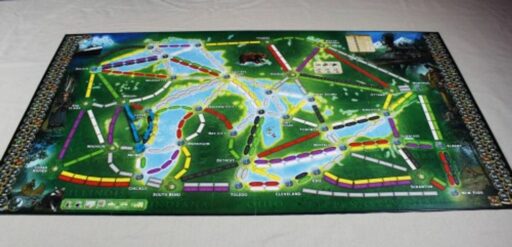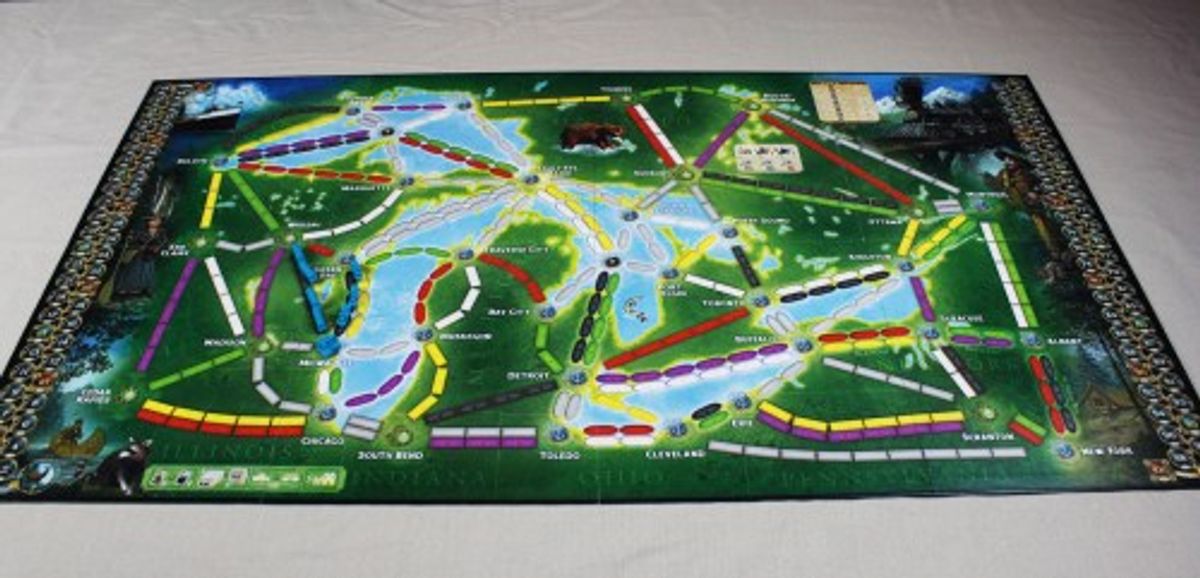Ticket to Ride has emerged as a beloved board game for both casual and competitive players, offering a blend of strategy and luck as participants build train routes across various maps. The game’s appeal lies in its simplicity and the subtle depth of its gameplay, making it a mainstay for game nights. Whether you’re a seasoned railroader or new to the locomotive escapades, our ‘Ticket to Ride Board Game: The Ultimate Strategy Guide’ will help you navigate the tracks to victory with advanced tactics, edition-specific advice, and social gameplay tips. Get ready to embark on a strategic journey through the world of Ticket to Ride!
Key Takeaways
- Understanding the core mechanics is crucial for success, from collecting the right cards to efficiently claiming routes.
- Advanced players can maximize their scores by focusing on long-distance routes and implementing effective blocking strategies.
- Each Ticket to Ride edition offers unique challenges and tactics, with Rails & Sails providing a fresh twist on the classic formula.
- Social dynamics play a significant role, as players must navigate competition, form alliances, and sometimes engage in bluffing.
- The game’s versatility makes it suitable for various settings, from a relaxed family night to a competitive party atmosphere.
Mastering the Basics of Ticket to Ride

Understanding Game Mechanics
To grasp the essence of Ticket to Ride, it’s crucial to understand the game mechanics that drive competition and strategy. To win Ticket to Ride, you must collect the most victory points by the end of the game. The end of the game is triggered when a player has two or fewer trains, signaling all players to make their final moves. Victory points are primarily earned by successfully completing train routes between cities, with longer routes being more valuable.
Players must carefully choose which routes to pursue, as some are inherently more valuable than others. This decision-making process is at the heart of the game’s strategy:
- Do you aim for longer, more valuable routes that may be riskier to complete?
- Or do you focus on shorter routes that can be completed more quickly for a steady score?
Failure to complete your claimed routes by the game’s end results in a loss of points, adding a layer of risk to every decision.
Each turn, players can take cards, claim a route, or get new destination tickets. This simple yet deep gameplay loop requires players to constantly adapt their strategies based on the actions of their opponents and the availability of resources.
Strategies for Collecting and Using Cards
In Ticket to Ride, the art of card collection is a delicate balance between biding your time and seizing opportunities. Collecting sets of cards that match the colors of desired routes is crucial, but so is the timing of when to play them. A common strategy is to accumulate cards in hand until you can claim a route in one go, preventing others from guessing your plans.
- Always be aware of the cards available in the draw pile and adapt your strategy accordingly.
- Consider the potential benefits of drawing blind from the deck versus selecting a visible card.
- Keep an eye on your opponents’ actions to anticipate their needs and possibly block crucial routes.
Remember, holding too many cards can be risky as it makes you a target for the ‘Train Robber’ card in some editions, which can force you to discard if you’re caught with too many cards in hand.
Diversifying your card collection can also be beneficial, allowing for more flexibility in route selection and the ability to adapt to changing game dynamics. However, spreading yourself too thin may leave you unable to complete your most valuable routes, so choose wisely.
Balancing Train and Ship Routes
In Ticket to Ride, balancing your approach between train and ship routes is crucial for victory. While train routes are the backbone of your network, ship routes often present opportunities for higher scoring and strategic expansion. However, players must be wary, as focusing too much on one type of route can lead to a lopsided strategy that’s easy for opponents to counter.
Balancing your resources to build a network of both trains and ships is key to outmaneuvering your opponents and securing the most lucrative routes.
Here are some considerations to keep in mind:
- Assess the board early to identify key routes that offer the best balance of points and accessibility.
- Monitor your card hand to ensure you have the right mix of train and ship cards.
- Be flexible in your strategy, ready to pivot between land and sea as the game progresses and opportunities arise.
Advanced Strategies for Seasoned Players

Maximizing Points with Long-Distance Routes
In the quest for victory in Ticket to Ride, longer rail lines mean larger profits. This principle is at the heart of a winning strategy, as securing these lucrative routes can lead to a significant point advantage. However, this approach is not without its risks. Players must weigh the potential rewards against the possibility of not completing these ambitious projects before the game’s end, which could result in a loss of points.
- Prioritize collecting a substantial number of cards before attempting to claim long routes.
- Monitor opponents’ actions to anticipate which routes might become contested and plan accordingly.
- Be strategic about the timing of claiming routes to maximize efficiency and minimize the risk of being blocked.
While the allure of quick scores from shorter routes is tempting, focusing on long-distance routes can be a game-changing move. It’s a delicate balance between ambition and caution, ensuring that you don’t overextend and leave routes unfinished.
Remember, the key to mastering long-distance routes is not just about claiming them; it’s about completing them. A well-executed strategy that includes securing these routes can often be the difference between a good game and a great victory.
Effective Blocking Techniques
In the strategic landscape of Ticket to Ride, effective blocking is as crucial as building your own routes. It’s a delicate balance between advancing your goals and hindering your opponents’. To excel in this area, consider the following points:
- Always be observant of your opponents’ actions. Their card draws and route choices can reveal their strategies, allowing you to intervene effectively.
- Timing is key. Block too early, and you may waste resources; too late, and the opportunity may have passed.
- Create a zig-zagging route from east to west to block other players, especially in games with higher player counts where the board becomes more crowded.
While blocking can be a powerful tactic, remember that it should not overshadow your primary objectives. It’s a supplementary strategy that, when used judiciously, can secure a win.
Remember, the goal isn’t just to sabotage but to do so in a way that also propels you towards victory. As the game progresses, stay adaptable and ready to pivot your blocking strategies as the board evolves.
When to Take Risks vs. Playing It Safe
In the strategic journey of Ticket to Ride, knowing when to take risks and when to play it safe is crucial for victory. Risk-taking can lead to high rewards, such as securing valuable long-distance routes that can significantly boost your score. However, it also comes with the potential for setbacks, especially if you fail to complete your ambitious routes.
- Playing it safe might involve focusing on shorter, more achievable routes that ensure a steady accumulation of points.
- Taking risks could mean aiming for those high-value routes or trying to block an opponent’s path, which can be a game-changing move.
The key is to assess the state of the board, the resources in your hand, and the progress of your opponents. A well-timed risk can catapult you into the lead, but an ill-considered gamble might leave you trailing behind.
Ultimately, the decision to take a risk or play it safe should be informed by your current position in the game and your ability to adapt to the unfolding dynamics. Keep a close eye on your opponents’ strategies and be ready to pivot your approach if the situation calls for it.
Edition-Specific Tactics

Adapting to Different Maps and Challenges
Each expansion of Ticket to Ride introduces new maps that demand players to rethink their strategies. Adapting to these variations is crucial for success. For instance, the ‘Map Collection 8‘ adds a layer of complexity with its unique requirements, echoing the diversity and challenge celebrated by fans on BoardGameGeek.
- Europe: Tunnels and ferries introduce new strategic decisions.
- Asia: Team play requires a different approach to route planning.
- India: A bonus for circular routes incentivizes a more circuitous playstyle.
While the core mechanics remain, each map’s distinct features can significantly alter gameplay dynamics.
Understanding the nuances of each map is essential. Some may have terrain that affects route building, while others might introduce new types of cards or objectives. Players must be willing to evolve their tactics and embrace the unique challenges presented by each new map to maintain their competitive edge.
Pros and Cons of Various Ticket to Ride Editions
Ticket to Ride has established itself as a family favorite, with its broad appeal and high replayability making it a staple in many collections. Each edition brings its own flavor to the table, offering new challenges and experiences. However, not all editions are created equal, and players may find that some versions resonate more with their personal preferences than others.
-
Pros:
- Great for train enthusiasts and those new to strategy games.
- The board can be laid out differently each time, enhancing variety.
- Several expansions and editions cater to different tastes and play styles.
-
Cons:
- Some editions may lack depth for more experienced gamers.
- The theme, while charming, might not be the most exciting for all players.
- Players with weaker negotiation skills may find certain editions more challenging.
While Ticket to Ride is competitive, it maintains a balance that rarely leads to conflict among players. It’s a puzzle that players work on individually, making it an excellent choice for a relaxed yet engaging game night.
Leveraging Unique Features in Rails & Sails
The Ticket to Ride Rails & Sails edition brings a refreshing twist to the beloved series, introducing a dual-mode of transportation that requires players to balance their strategies between rail and sea routes. With a double-sided board featuring the world map and the Great Lakes of North America, the game offers a vast array of routes to conquer.
- Strategic Depth: Players must now manage two separate decks for trains and ships, adding a layer of complexity to their planning.
- Route Diversity: The inclusion of sea routes opens up new pathways and strategic possibilities.
- Component Variety: Additional components such as harbors and shipyards offer unique strategic options.
The fast learning curve of Rails & Sails ensures that both veterans and newcomers can quickly dive into the strategic fun. Expanding your journey across the globe or the Great Lakes brings a dynamic challenge to the Ticket to Ride experience.
The game’s elegant simplicity allows for family and friends to enjoy hours of gameplay, while also providing enough depth for seasoned players to explore new strategies. Whether you’re setting sail for new horizons or chugging along well-known tracks, Rails & Sails is sure to delight and challenge.
Social Dynamics and Player Interaction

Navigating Competition and Alliances
In the strategic landscape of Ticket to Ride, alliances can be as transient as the routes on the board. Players must be adept at reading the table and anticipating moves, as thinking ahead is crucial for success. Forming temporary alliances may provide strategic advantages, such as sharing routes or information, but one must always be wary of betrayal.
While the game’s objective is clear, the paths to victory are not always straightforward. It’s not just about building the longest train or completing the most tickets; it’s about outmaneuvering your opponents and, when necessary, hemming in opponents to limit their options. This competitive edge is not about accumulating wealth but about strategic expansion and cultivating a larger population of routes.
In the realm of Ticket to Ride, expect the unexpected. Adaptability is key, as each player’s strategy can drastically alter the state of the board. Be prepared to forge alliances, but also to dissolve them when they no longer serve your journey to victory.
Here are some key considerations when navigating competition and alliances:
- Always be aware of your opponents’ goals and adapt your strategy accordingly.
- Consider the benefits and risks of forming alliances, and choose your allies wisely.
- Remember that alliances in Ticket to Ride are not binding; be ready to act independently when needed.
Psychological Aspects of Gameplay
The psychological landscape of Ticket to Ride is as varied as its physical maps. Players must navigate not only the game board but also the minds of their opponents. Understanding the motivations and predicting the moves of fellow players can be as crucial as the strategic placement of your trains.
- Recognizing patterns in opponents’ behavior
- Adapting to the psychological pressure of the ticking clock
- Maintaining a poker face to conceal your own strategies
Mastering the psychological game is about more than just keeping a straight face; it’s about weaving a narrative that others will follow, leading them away from your true intentions.
Boardgames are regarded as effective learning tools, encouraging motivation, engagement, and behavior change while fostering understanding of complex systems. This is particularly true in Ticket to Ride, where the ability to read the room can turn the tide of the game.
The Role of Negotiation and Bluffing
In the realm of Ticket to Ride, the art of negotiation and bluffing can be as crucial as the strategic placement of your trains. Negotiation skills are paramount, especially when it comes to trading routes or deterring opponents from key locations. A well-timed bluff can lead rivals to believe you’re pursuing a different strategy, allowing you to complete your routes with less interference.
While Ticket to Ride is not inherently a negotiation-heavy game like Catan, the subtle art of bluffing plays a significant role in outmaneuvering your opponents.
Understanding your opponents’ strategies is essential. By carefully observing their moves, you can anticipate their needs and potentially block their path. This is where the psychological gameplay comes into play, as you decide when to reveal your intentions or keep your plans hidden. The ability to read the game board and the players around it can turn the tides in your favor.
Here are some key points to consider when incorporating negotiation and bluffing into your gameplay:
- Recognize the importance of trading routes strategically.
- Use bluffing to mislead opponents about your true objectives.
- Observe opponents’ actions to anticipate their strategies.
- Decide the right moment to reveal or conceal your plans.
Enhancing the Ticket to Ride Experience
Creating a Thematic Game Night
To transform your Ticket to Ride evenings into thematic game nights, start by setting the scene with decorations that reflect the various destinations on the game board. Use travel posters, vintage suitcases, and even regional snacks to immerse players in the adventure.
Next, consider the ambiance. Background music can be curated to match the game’s setting, whether it’s the bustling streets of New York or the serene landscapes of the Nordic countries. A playlist that evokes the spirit of the destinations can greatly enhance the experience.
Here’s a simple checklist to ensure you don’t miss any details:
- Decor matching game destinations
- Regional snacks and beverages
- Curated background music
- Themed attire (optional but fun)
- Travel-inspired prizes for winners
Embrace the journey of Ticket to Ride by creating an atmosphere that celebrates the essence of travel and exploration. This not only makes the game more engaging but also creates unforgettable memories with friends and family.
Incorporating House Rules for Added Fun
Introducing house rules to your Ticket to Ride sessions can refresh the game and provide a personalized touch that caters to your group’s preferences. House rules can range from quirky challenges to strategic twists, ensuring that each game feels unique and engaging.
Here are a few ideas for house rules you might consider:
- Bonus Points: Award extra points for completing routes with a specific color of trains.
- Train Robber: Allow players to ‘steal’ a route from another player once per game.
- Double Trouble: Double the points for a route if you can complete it in a single turn.
Remember, the goal of house rules is to enhance the fun and possibly balance the gameplay. It’s important to agree on these rules before starting the game to avoid any mid-game disputes.
While house rules are meant to add excitement, they should not overcomplicate the game. Keep them simple and ensure they align with the spirit of Ticket to Ride. After all, the core of the game’s appeal is its elegant simplicity and the strategic decisions it requires from players.
Ticket to Ride in Different Settings: Couples, Families, and Parties
Ticket to Ride offers a versatile gaming experience that can be tailored to different social settings, whether it’s a quiet evening with your partner, a lively family game night, or a competitive party atmosphere. For couples, the game provides an intimate battleground for strategic minds. Playing two consecutive matches on the same board, as suggested by a BoardGameGeek user, can heighten the excitement and challenge, making it a better experience for two players.
When it comes to families, Ticket to Ride strikes a perfect balance between competition and fun. It’s competitive enough to keep players engaged, but not to the point of causing disputes. The game’s appeal lies in its sedate puzzle-like nature, where each player works on their own strategy to connect cities and complete routes.
Parties bring a different dynamic to the game. With more players, the competition over routes intensifies, and the game becomes a lively social event. Here’s a quick guide to choosing the right Ticket to Ride edition for your next gathering:
- Couples: Ticket to Ride New York for a quick and engaging match.
- Families: The classic Ticket to Ride for its broad appeal and replayability.
- Parties: Ticket to Ride Rails and Sails for a more complex and expansive experience.
Remember, the key to a great Ticket to Ride session is choosing the right edition that matches the group’s mood and preferences. Whether it’s the simplicity and speed of the New York version for couples or the expansive adventure of Rails and Sails for parties, there’s an edition for every occasion.
Conclusion
In wrapping up our ultimate strategy guide for Ticket to Ride, it’s clear that this game has cemented its place as a beloved classic in the board game world. With its broad appeal, variety of editions, and exceptional replayability, Ticket to Ride offers an accessible yet engaging experience for players of all ages. Whether you’re a veteran railroader or new to the tracks, the strategies discussed can enhance your gameplay and bring new excitement to your board game nights. Remember, while the theme may not be the most thrilling for everyone, the joy of building your train empire and outmaneuvering opponents provides a delightful blend of strategy and fun. So gather your friends and family, set sail on new adventures with Rails & Sails, or enjoy the classic routes—Ticket to Ride is a journey worth taking time and time again.
Frequently Asked Questions
What is Ticket to Ride Rails & Sails?
Ticket to Ride Rails & Sails is the latest installment in the popular train adventure series. It allows players to collect cards of various types, such as Trains and Ships, to claim railway and sea routes on a double-sided board featuring the world map and the Great Lakes of North America.
How does Ticket to Ride compare to Monopoly?
Ticket to Ride and Monopoly share similarities in that both games involve growing an empire and maximizing profits. Ticket to Ride is often seen as a gateway to strategy games with a train theme, while Monopoly focuses on real estate and capitalism.
Is Ticket to Ride suitable for family game nights?
Yes, Ticket to Ride is highly suitable for family game nights. Its easy-to-learn mechanics and the potential for non-confrontational play make it a relaxing and enjoyable experience for players of all ages.
Can Ticket to Ride be played in different settings?
Absolutely! Ticket to Ride is versatile and can be played in a variety of settings, including with couples, families, and at parties. The game’s broad appeal and numerous editions make it extremely replayable and adaptable to different group sizes and dynamics.
What makes Ticket to Ride a good choice for couples on double dates?
Ticket to Ride is a great choice for couples on double dates because it’s a competitive yet friendly game that encourages players to complete train routes on various maps. It also offers additional challenges like completing long-distance routes or blocking opponents, which can add a fun twist to the gameplay.
Are there different editions of Ticket to Ride?
Yes, there are many different editions of Ticket to Ride, each with its own unique maps and challenges. This variety allows players to enjoy new experiences and strategies with each edition, keeping the game fresh and exciting.





